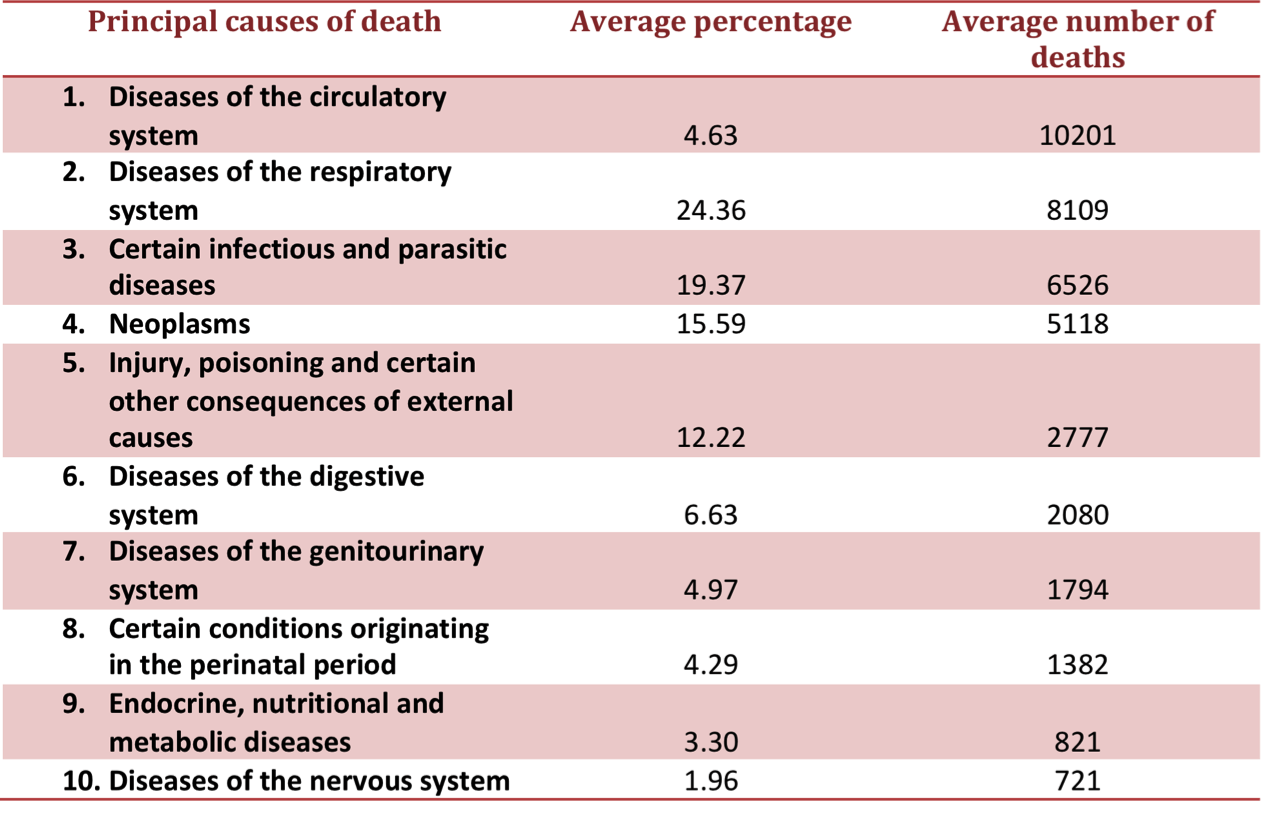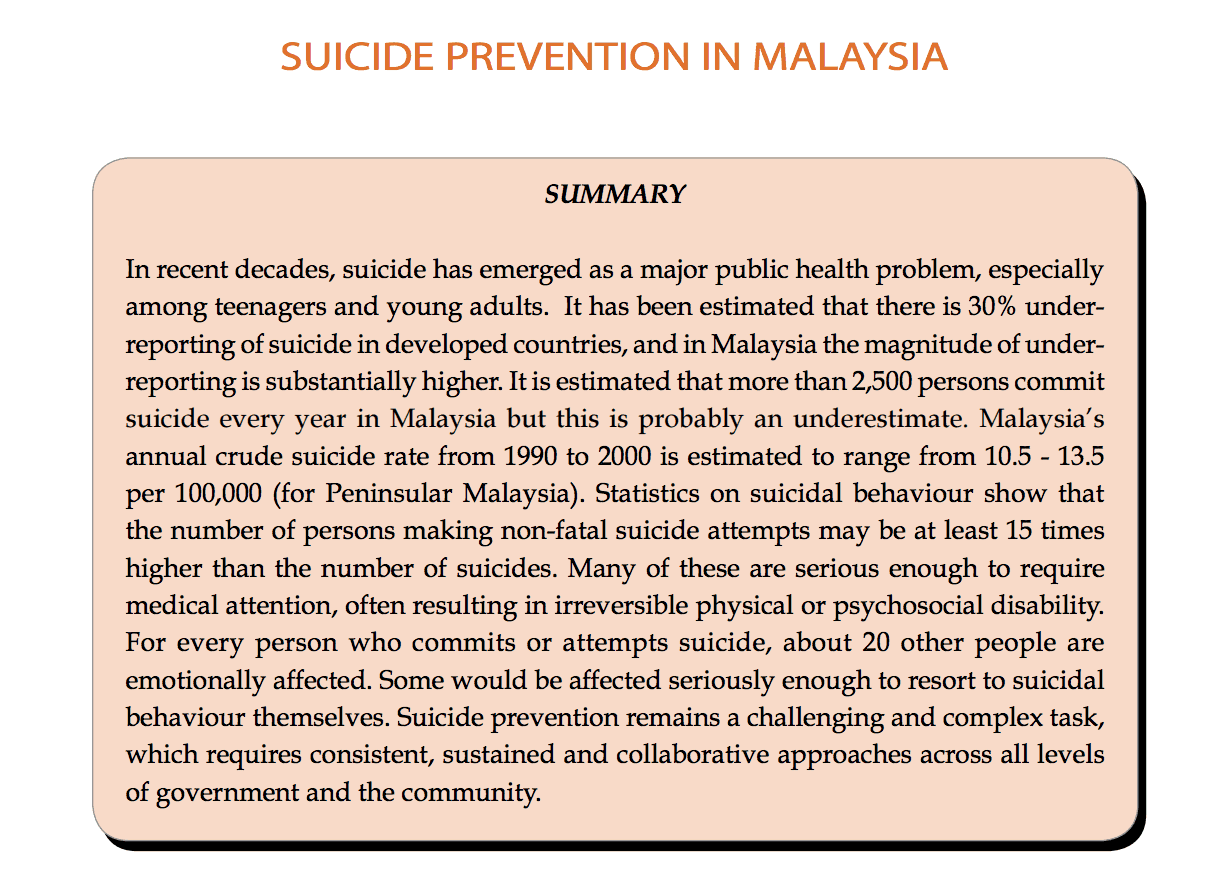By Dr. Chua Sook Ning
In 2005, the Ministry of Health (MOH) conceded that the rate of suicide is severely underestimated and that the true rate of suicide ranges from 10. 5 – 13.5 people per 100000 (Malaysia Health 2005, p. 162). Below is a screenshot of the summary posted in the report.
How does the rate of suicide compare to other causes of death in Malaysia?
Let’s take 12 per 100000 as the average annual crude suicide rate (the midpoint of 10.5 – 13.5).
In a population of 30 million people, this means 3600 people die per year, or 10 people per day by suicide.
To examine how this compares to other causes of death, we examined the statistics published by MOH in the Annual Health Reports and Health Facts.
- MOH only started using ICD 10 categories to classifications of death from 2010 onwards.
- MOH has published only 3 reports after 2010 (2010 – 2012). Only the 2010 and 2011 Annual Health Reports provide the actual number of death in each category.
- The Health Facts reports provide percentages of death in each category but not the actual numbers. Thus, we don’t know how many people have died from these causes.
- The Annual Health Report of 2003, 2004, 2005, 2006, 2008 and 2009 provide the actual number of deaths but not using conventional ICD categories.
- The 2002 Annual Health Report does not provide the actual number of deaths: “Owing to the lack of up-to-date mortality data from the Department of Statistics, it is thus not possible to say what proportion the medically certified (hospital) death constitutes in relation to total deaths in the country” (p. 6).
- The 2007 Annual Health Report which has not been posted in its entirety (only the first and last page has been posted).
- Therefore, we know the total number of deaths in MOH hospitals from 2003-2011 (except 2007) and the percentages of deaths in ICD categories from 2010 – 2015.
- We can calculate the average number of deaths per year in MOH hospital. The average number of deaths in MOH hospitals is 41873.
- We can calculate the average percentage in each ICD category.
- We can calculate the average number of people who died in each ICD category using the average number of death per year and the average percentage in each ICD category.
Table 1. The top 10 causes of death in MOH hospitals in Malaysia from 2010-2015.
So where does suicide fit in? Right in the middle.
Using data published by MOH, we can extrapolate that suicide is the number 5 cause of death in Malaysia.
75% of global suicides occur in low- and middle-income countries.
WHO
That’s Malaysia, that’s us. We make a significant contribution to the number of suicides in the world.
Myths of suicide.
1.If someone is suicidal, they will always be suicidal.
Feelings of wanting to commit suicide are often brought on by stressful life situations, accompanied with feelings of hopeless and sadness. Heightened suicide risk is often short-term and situation specific. People can recover and find meaning in life again.
2.Talking about suicide is a bad idea and can increase the chances of suicide.
With the widespread stigma against suicide and the law against suicide, people may be afraid to talk about their thoughts of death and wanting to die. Contrary to popular opinion, talking about suicide openly actually decreases the possibility of suicide and helps the person see other options other than suicide.
3.Only people with mental disorders are suicidal.
Although mental illness does increase the risk of suicide, people with mental illness are not necessarily suicidal and people who are suicidal do not necessarily have a mental illness. People who commit suicide usually feel hopeless and in distress, and about 75% of suicides are committed by individuals with a mental illness.
4. Most suicide happens out of the blue and without warning.
Majority of suicides happen with verbal (e.g. talking about feeling like a burden) or behavioural warnings (e.g. isolating themselves from family and friends). You can read more about warning signs here.
5. People who are suicidal are determined to die.
People who are suicidal often have mixed feelings about dying or living. They have reasons to live and to die. Encouraging an open conversation about suicide can help someone see their reasons for living.
6.People who talk about suicide do not mean to do it.
People who talk about death and wanting to take their lives are usually feeling hopeless, sad and anxious. This is a cry for help and a way to get support. Care for them by taking their feelings seriously.
All suicidal threats and attempts must be taken seriously. If you know someone who is going to attempt suicide, please call 999.
Dr. Chua Sook Ning is a Clinical Psychologist and a lecturer at the National Institute of Education at Nanyang Technological University, Singapore. She believes in raising public awareness of mental health by encouraging open and public conversations of mental health. She also is also working on early identification of mental health conditions by promoting mental health screenings and. training communities to recognize mental health conditions. Finally, she is working with a team of international researchers to develop accessible and affordable mental health interventions.






0 Comments